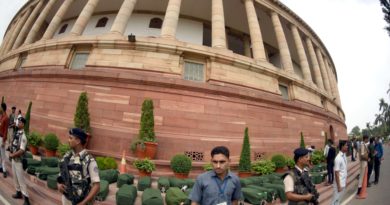RAJA Ram Mohun Roy
Google has honoured Raja Ram Mohun Roy calling the ‘Maker Of Modern India’ with a doodle on the occasion of his 256th birth anniversary. Raja Ram Mohan Roy (1772-1833) is considered as the pioneer of modern Indian Renaissance for the remarkable reforms he initiated in the 18th and 19th century India. Braving stiff opposition, including repeated threats to his life from the then puritanical Indian society, he fought for abolition of brutal and inhuman Sati Pratha and was instrumental in eradicating the purdah system and child marriage. In 1828, Ram Mohan Roy formed the Brahmo Samaj based on the principles Vedanta trying to free the society from man-made numerous rituals and social practices curbing human rights. A linguist and scholar well versed in Vedas , Puranas , Persian , English and Sanskrit, he had revolted against polygamy, burning alive of women on the pyres of their spouses and keeping women illiterate despite belonging to the upper caste of Hindu society . He was not a Raja or a king. The Honorific title was given by the then Mughal Emperor to enable him plead for hiking his pensionery benefit with the Government in London. Lord William Bentinck, the then Governor General of Colonial India, had okayed abolition of Sati system. But Ram Mohun was convinced that these needed to be legalised. Hence, after uniting the Bhramos, a group of people, who had no faith in idol-worship and were against the caste restrictions, he decided to sail for England. The title ‘Raja’ was bestowed upon him by the Mughal emperor Akbar II in 1831 empowering him as an ambassador of the Mughal King and ensuring he had hassle free access to the concerned higher authorities abroad. Unfortunately, well-meaning and workaholic missionary despised by the so-called leaders of the Hindu society died of meningitis in 1833 while residing in Bristol, England. The champion for women empowerment has inspired Pandit Ishwar Chandra Vidyasagar, Bankim Chandra Chatterjee, Rabindra Nath Tagore, Sarat Chandra Chatterjee and many other poets, writers and intellectuals in Bengal for ages. After his demise Raja Ram Mohan Roy was buried at the Arnos Vale Cemetery in Bristol. Many years later, the British government has named a street in Bristol as ‘Raja Rammohan Way’ in his memory.
Ram Mohan intended to implement social reforms through education. One year after his arrival in Kolkata in 1815 he started an English medium College meeting the expenses from his own pocket. He was among the pioneers in India to welcome English language for opening the gateway to knowledge when Persian was the country’s official language. But it will be a grave mistake on our part to debunk him that he was a Darbari.His envisioned that English knowing Indians could criticize the government’s policy of opening only Sanskrit schools. After himself becoming well-versed in English language, he tried to convince his compatriots that Indians would remain far behind if they had no opportunity to study modern subjects like Mathematics, Geography and Latin. Government accepted this idea of Ram Mohan and also implemented it but not before his death. Narendra Nath Datta, later known as Swami Vivekananda, seems to be his soul mate although he never give up Hindu faith and a great scholar in Sanskrit and English language. English became his medium of interaction to travel across the world, debate with elites, convincing English speaking Americans and Bitts about his interpretation of religion. His soul stirring speech at the 1893 World parliament of Religions in Chicago still remains inspiring. It is through English the Swamij had narrated Vedantic knowledge.
Raja Rammohum Roy was instrumental in setting up the Hindu College in Kolkata the Anglo-Hindu School and the Vedanta College. He also penned Sambad Kaumudi championing freedom of the press.
Ram Mohan was also the visionaries who accorded importance to the development of the mother tongue. His ‘Gaudiya Byakaran’ in Bengali is the best of his prose works. The son of a wealthy influential and orthodox individual who and strictly followed religious duties had reservation about his father’s way of life from childhood. .Even during colonial India, he stressed the need for a free press and free speech and expression which now integral part of the Indian constitution. He had fought for the right of vernacular press and himself brought out and edited titled Miratul- Akhbar’ (the Mirror of NewsLegacy) .During his visit to United Kingdom, Raja Ram Mohan Roy died of meningitis at Stapleton in Bristol on 27 September, 1833. He was buried at the Arnos Vale Cemetery in Bristol. Recently, the British government has named a street in Bristol as ‘Raja Rammohan Way’ in the memory of Raja Ram Mohan Roy.




